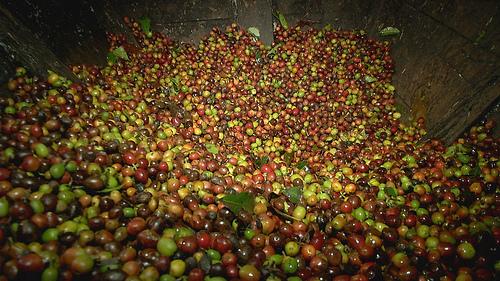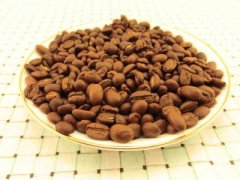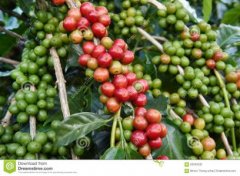A brief introduction to the treatment method of grinding degree and baking degree of Indonesian Mantenin boutique coffee beans with rich mellow degree

Generally linton mantelin is baked until the second explosion, which can reduce the miscellaneous flavor, but gold mantelin has good transparency and sweetness before or after the second explosion, and the baking space is wider. The unique herbal fragrance and heavy wood flavor of mantelin. Due to high humidity, the pectin layer is dried in three stages. This is also a rare treatment in the world, which accidentally creates a low acid, thick and smoky flavor of mantadine. Due to the variety of three-stage drying method and rough processing method, Mantenin can be called the most unstable quality of fine coffee. Chop beans, moldy beans, black beans, and unripe beans abound, making it a headache for bakers to spend a lot of time picking out defective beans before baking, but that doesn't detract from the world's preference for full-bodied mantelin. In order to improve the problem of high defective beans of mantning, the Japanese adopted stricter quality control more than ten years ago. After drying raw beans, they were screened by density and color separation. Finally, they were manually selected four times to eliminate defective beans and produce dark green gold mantning with uniform bean phase.
Sellers often label Lintong Lindong and Mandheling Mandheling coffees as dry processed. In fact, the pulp is often separated from the coffee seeds by a variety of mixing modes, more commonly a backyard wet treatment. Clever farmers put freshly picked coffee cherries into a crude peeling machine assembled from scrap metal, wood and bicycle parts. The peeled, sticky beans are then fermented overnight in plastic woven bags. The next morning, wash off the soft, fermented pulp and stickiness by hand. The silver-coated coffee is pre-dried on a sheet in the front yard and sent to a middleman's warehouse where the silver is removed and further dried. Finally, the coffee is trucked to Medan Port (capital of Sumatra) for the third and final drying.
It has also been reported that in other Mandheling regions, after removal of the pericarp, the mucilage is allowed to dry and adhere to the beans, as is done in Brazil with semi-washing. After that, the dried slime and silver skin are removed by machine. Finally, the same two-stage drying process takes place, first at the warehouse of the middleman and then at the warehouse of the exporter in Medan Port.
Process with Sumatra characteristics. I describe these processes in such detail because it is not clear to what extent soil and atmosphere and unusual treatment techniques and three-stage drying each affect the formation of the characteristics of Linton and Mantenin coffee. Only one thing is certain. These treatments occasionally produce excellent coffee but are also extremely unstable. Only relentless picking in the Medan Port exporter's warehouse ensures that the depth of texture and distinctive understated richness of Lintong and Mandheling emerge from the interference of other odors.
Mantenin coffee is produced in Sumatra, Indonesia, Asia, otherwise known as "Sumatra coffee." The main habitats are Java, Sulawesi and Sumatra, 90% of which are Robusta species. The most famous of these is the mantinin from Sumatra. The finest of the fine traditional Arabica coffees produced in Sumatra North are marketed under the titles Lintong and Mandheling. Lintong is a coffee grown in a small area southwest of Toba Lake in Lindong Administrative District. Its flavor is very rich, fragrant, bitter, mellow and slightly sweet. Most coffee lovers drink it as a single item, but it is also an indispensable variety for blending coffee.
Mantelin has a strong taste, with rich alcohol and rich and lively movement, not astringent or sour, alcohol and bitterness can be fully revealed. The appearance of the mantnin beans is arguably the ugliest, but coffee fans say the uglier the sumatra beans are, the better, mellower and smoother they taste.
Gold mantelin tastes cleaner than lindon mantelin. The original herbal, earthy and woody flavors of mantelin are almost gone, but the caramel sweetness is stronger and the fruit acid flavor is brighter and more elegant.
Mantelin coffee is considered to be the world's most mellow coffee, in the taste of mantelin, you can feel the obvious lubrication on the tip of the tongue, it also has a low acidity, but this acidity can also be clearly tasted, jumping slightly acid mixed with the most intense aroma, so that you can easily experience the lively factors in the mild fragrance. In addition, this coffee also has a light earthy aroma, some people describe it as herbal aroma.
Mantenen needs layers of screening, which I think is absolutely necessary. The probability of defective beans is too high, plus the ugly appearance, sometimes good beans look like defective beans. Every time I pick Mantenin, I can pick out a handful of defective beans. When I look back at the defective beans, I feel that it is not a defective bean. It looks like this.
However, after roasting, Mantenin was like a caterpillar breaking out of its cocoon into a butterfly. The ripe beans were very plump and looked quite pleasing to the eye. The main reason was to buy Mantenin coffee. Almost all the best producing areas in Indonesia had been bought by it, so most of the beans produced by PWN were also unique and high-quality. Golden Mantelin was the product produced by this company. After the raw beans were purchased, they would undergo multiple manual selections to select the full and flawless beans. Finally, these good beans could be classified as Golden Mantelin. However, PWN Company registered the trademark of Gold Mantelin, which means that only the gold Mantelin produced by PWN Company can be regarded as the real "Gold Mantelin" in the future. Many beans on the market that were not made by PWN and hung with the gold Mandolin brand should actually be called fine Mandolin. "Golden mantinin" is not an old bean, but a product named by the company
Important Notice :
前街咖啡 FrontStreet Coffee has moved to new addredd:
FrontStreet Coffee Address: 315,Donghua East Road,GuangZhou
Tel:020 38364473
- Prev

A brief introduction to the planting situation of Indonesia's Mantenin boutique coffee beans, geographical location, climate and altitude
Sellers often mark Lintong Lindong and Mandheling Manning coffee as dry. In fact, the pulp and coffee seeds are often separated by a variety of mixing modes, and the more common is a backyard wet treatment. The smart farmer put the freshly picked coffee cherries into a simple peeling machine made of scrap metal, wood and bicycle parts. Then stick the peeled ones.
- Next

A brief introduction to the Market Price of St. Helena Coffee varieties begged by Napoleon on his deathbed
Source of seeds on February 10, 1733, a ship from the British East India Company (The East India Company) from the Yemeni port of Moka brought Green Tipped Bourbon Coffee seeds, which began to be planted all over St. Helena and grew luxuriantly, even if neglected. Once, the French proudly announced to the world that they had their own.
Related
- Detailed explanation of Jadeite planting Land in Panamanian Jadeite Manor introduction to the grading system of Jadeite competitive bidding, Red bid, Green bid and Rose Summer
- Story of Coffee planting in Brenka region of Costa Rica Stonehenge Manor anaerobic heavy honey treatment of flavor mouth
- What's on the barrel of Blue Mountain Coffee beans?
- Can American coffee also pull flowers? How to use hot American style to pull out a good-looking pattern?
- Can you make a cold extract with coffee beans? What is the right proportion for cold-extracted coffee formula?
- Indonesian PWN Gold Mandrine Coffee Origin Features Flavor How to Chong? Mandolin coffee is American.
- A brief introduction to the flavor characteristics of Brazilian yellow bourbon coffee beans
- What is the effect of different water quality on the flavor of cold-extracted coffee? What kind of water is best for brewing coffee?
- Why do you think of Rose Summer whenever you mention Panamanian coffee?
- Introduction to the characteristics of authentic blue mountain coffee bean producing areas? What is the CIB Coffee Authority in Jamaica?

